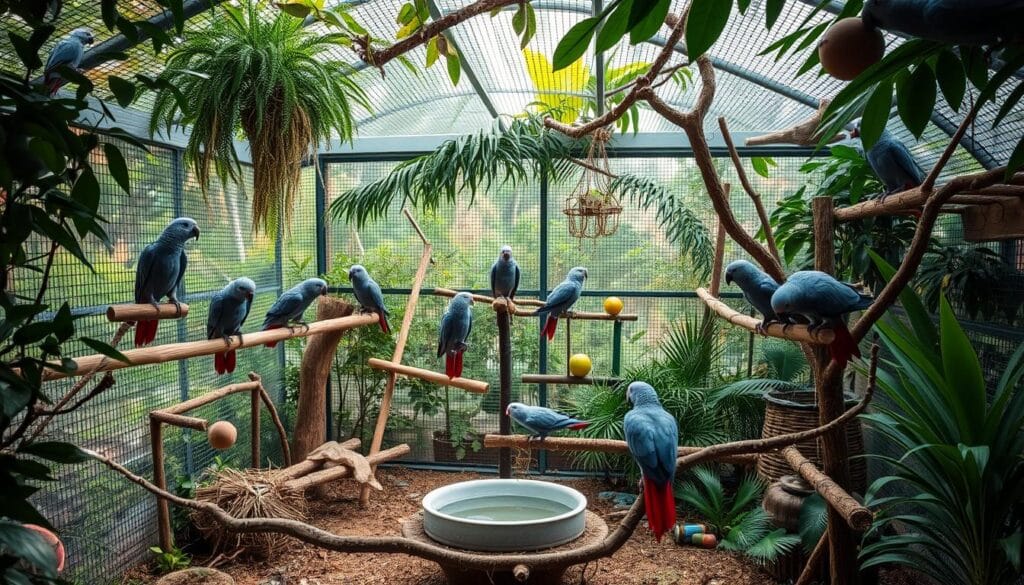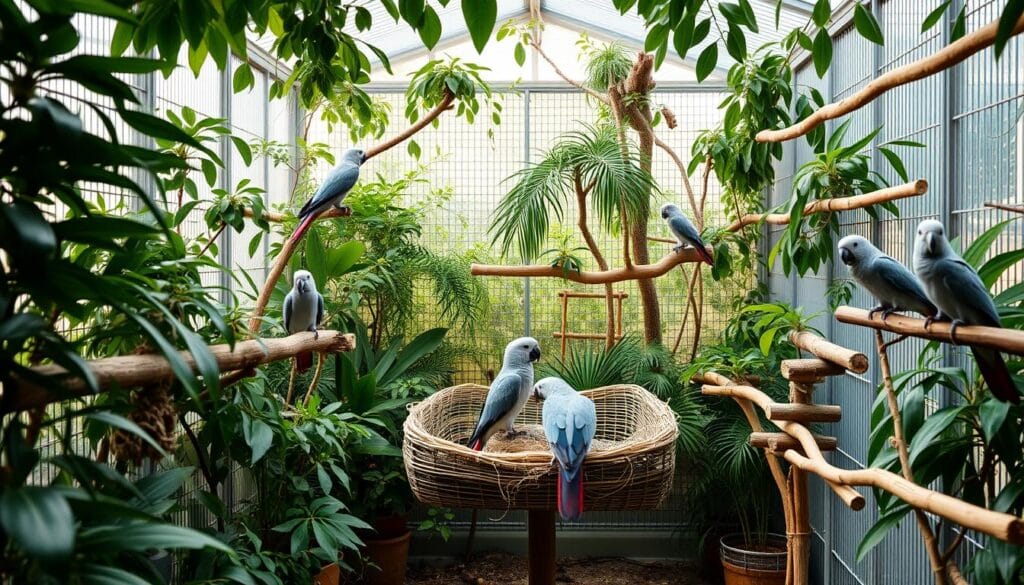Gray parrot breeding is a complex process that needs careful planning and attention. It’s rewarding but requires a deep understanding of these birds’ needs. This includes their diet, environment, and health.
Knowing the basics of gray parrot breeding is key to success. A suitable environment, balanced diet, and proper health care are crucial. By providing the right conditions, breeders can ensure their gray parrots’ health and well-being.
Exotic bird breeding, like gray parrot breeding, takes a lot of time and resources. It’s important to understand the challenges and responsibilities involved. This way, breeders can ensure their breeding program’s success and the birds’ health.
Introduction to Gray Parrot Breeding
Gray parrot breeding is both fascinating and rewarding. With the right knowledge and skills, breeders can raise healthy and thriving gray parrots. This guide will offer valuable insights and information on gray parrot breeding, from the basics to advanced care.
Table of Contents
Understanding Gray Parrot Breeding Basics
African gray parrot breeding needs a deep understanding of their natural behaviors and social needs. In the wild, these birds are smart and social, which impacts their breeding. To breed them successfully, it’s key to mimic their natural habits in a controlled setting.
Important aspects of gray parrot breeding include a suitable environment and diet. Also, knowing when they reach sexual maturity and the breeding season is crucial. By following parrot breeding tips and creating a caring environment, breeders can encourage natural behaviors and healthy breeding. Breeding African gray parrots is complex, requiring attention to detail and a commitment to their care.
Some key factors to consider when breeding African gray parrots include:
- Recognizing natural breeding behaviors, such as courtship displays and nest building
- Understanding the timing of sexual maturity and the considerations for the breeding season
- Providing a suitable environment and diet to encourage natural behaviors and promote healthy breeding
By following these parrot breeding tips and staying committed to their care, breeders can boost their success. Whether you’re experienced or new, understanding African gray parrot breeding basics is vital. It helps achieve your goals and build a successful breeding program.
Essential Requirements for Successful Breeding
To succeed in breeding, it’s key to create a breeding environment that feels like the birds’ natural home. This means keeping the right temperature, humidity, and light. Also, feeding them a balanced diet, keeping them healthy, and managing the breeding season well are important steps.
A good breeding environment is vital for the birds’ health and success. It should have a big aviary with good air flow, a diet that’s right for them, and a setup that helps with breeding. Using these techniques can help breeders raise healthy birds.
When setting up a breeding environment, consider these important points:
- Give them a balanced diet that’s good for their health.
- Make sure the birds are healthy and don’t have diseases.
- Manage the breeding season well to increase the chances of success.
- Create a setup that helps with breeding.

By following these steps and setting up a good breeding environment, breeders can improve their chances of success. Remember, every breeding program is different. So, it’s important to keep up with the latest research and best practices to get the best results.
Selecting and Pairing Breeding Birds
When breeding exotic birds, like gray parrots, picking the right pair is key. You need to think about the birds’ health, age, and genetic background. Also, their compatibility is very important.
Choosing the right pair means looking at their age and health first. A good pair should be healthy and have a good temperament. Knowing their genetics helps avoid health problems in their offspring.
Key Factors in Breeding Pair Selection
- Age: The birds should be of breeding age, typically between 2-5 years old.
- Health: The birds should be free of genetic disorders and have a clean bill of health.
- Genetic background: The birds should have a diverse genetic background to minimize the risk of inherited health issues.
- Compatibility: The birds should have a compatible temperament and be able to coexist peacefully.
Exotic bird breeding, such as gray parrot breeding, needs a lot of knowledge. By picking the right pair, breeders can have a successful program. The aim is to raise healthy, diverse birds that will do well in their new homes.
Creating the Optimal Breeding Environment
Creating the right breeding environment is key for gray parrots’ health and success. This means thinking about aviary design, temperature, humidity, and nesting boxes. A good setup can make a big difference in breeding season management.
The aviary needs to be big, well-ventilated, and safe from harsh weather. Temperature and humidity levels should match the birds’ natural habitat. Using control systems helps keep the environment stable and comfy for the birds.
Aviary Design and Setup Considerations
- Provide ample space for the birds to fly and exercise
- Include perches, toys, and other enrichment activities
- Ensure proper ventilation and air circulation
Managing the breeding season also means controlling the environment. This way, breeders can better simulate natural breeding conditions. An optimal environment increases the chances of successful breeding and healthy parrots.

Nesting Box Specifications
Nesting boxes must meet gray parrots’ needs for a safe, comfy space. They should be well-ventilated, easy to clean, and safe from predators.
| Nesting Box Feature | Specification |
|---|---|
| Size | 12 inches wide, 12 inches deep, 24 inches tall |
| Material | Durable, easy-to-clean wood or plastic |
| Entrance Hole | 3 inches in diameter, 6 inches from the floor |
By following these guidelines, breeders can ensure the health and success of their gray parrots. This leads to a successful breeding season.
Gray Parrot Breeding Diet and Nutrition
A balanced diet is key for gray parrots’ health and breeding success. It’s important to offer a variety of foods to meet their nutritional needs. Parrot breeding tips recommend a high-quality commercial pellet as the main food. Add fresh foods to ensure they get all the nutrients they need.
Some important foods for a gray parrot’s diet include:
- Fresh fruits, such as apples and bananas
- Leafy green vegetables, like kale and spinach
- Whole grains, including brown rice and quinoa
- Protein sources, like nuts and seeds
Adding these foods to their diet supports their health and well-being. This leads to breeding success techniques that result in healthy chicks. It’s also crucial to avoid a seed-only diet and ensure they always have access to fresh water.
As a breeder, staying updated on parrot breeding tips and breeding success techniques is vital. Focus on their diet and nutrition to ensure their health and happiness for life.
Remember, a balanced diet is just one part of successful gray parrot breeding. Combine it with proper care and attention for the best results. This way, your birds will thrive, and you’ll have a higher chance of breeding success.
| Nutrient | Importance | Food Sources |
|---|---|---|
| Protein | Essential for growth and development | Nuts, seeds, commercial pellets |
| Calcium | Critical for strong bones and egg production | Dark leafy greens, crushed eggshells |
| Vitamins | Important for overall health and well-being | Fresh fruits and vegetables |
Monitoring the Breeding Process
Keeping a close eye on the breeding process is key. It helps spot problems early and keeps the parrots healthy. Parrot breeding tips can help avoid issues and boost breeding success. Watching the breeding pair’s behavior is important. Changes in their actions can signal trouble.
Choosing the right breeding pair is crucial. A good pair is more likely to breed well. Regular health checks are also vital. They help catch any issues before they get worse.
Challenges like infertility, egg binding, and chick death need quick action. To avoid these problems, you can:
- Feed them a balanced diet
- Keep their living space clean and safe
- Control the temperature and humidity
- Check the health of the pair and chicks often
By using these parrot breeding tips and watching the breeding closely, breeders can raise healthy parrots. This way, they increase their chances of successful breeding.
Caring for Eggs and Chicks
Proper care of eggs and chicks is crucial for their survival and health in exotic bird breeding, including gray parrots. Breeding success techniques involve creating a safe and stable environment for incubation. Also, providing the right care and nutrition for chicks after they hatch is key. This phase requires a deep understanding of the specific needs of the eggs and chicks, like temperature, humidity, and feeding schedules.
Some key considerations for caring for eggs and chicks include:
- Maintaining a consistent temperature between 98°F and 100°F
- Monitoring humidity levels to ensure optimal conditions
- Providing a nutritious diet for the chicks after they hatch
- Closely monitoring the health and development of the chicks
By following these breeding success techniques and providing the right care, exotic bird breeding enthusiasts can increase their chances of success. It is essential to stay informed and up-to-date on the latest research and best practices in exotic bird breeding to ensure the best possible outcomes.
With the right care and attention, gray parrot chicks can grow and develop into strong, healthy birds. By prioritizing their needs and providing a nurturing environment, breeders can help ensure the long-term success of their breeding program. This contributes to the conservation of these amazing birds.
Health Management During Breeding Season
Managing the breeding season well is key for gray parrot breeding success. It means keeping the environment clean, checking the birds’ health regularly, and watching their health closely. This way, breeders can lower health risks and have a successful breeding season.
Stopping diseases is important during the breeding season. This can be done through vaccinations, keeping things clean, and being careful about who comes in. Having plans for emergencies is also crucial. It lets breeders act fast if health problems come up. Getting help from a vet is also vital for advice and treatment.
Some important things for health management during the breeding season include:
- Regular health checks to find health problems early
- Using biosecurity to stop diseases from spreading
- Having vet support and emergency plans
By focusing on health and using good breeding season management, breeders can keep their birds healthy. This leads to a successful breeding season. It also means knowing and using breeding success techniques well.
| Health Management Considerations | Importance |
|---|---|
| Regular health checks | High |
| Biosecurity measures | High |
| Veterinary support | High |
Conclusion: Keys to Successful Gray Parrot Breeding
There’s no single secret to successful gray parrot breeding. It’s all about combining key elements. Understanding the needs and behaviors of these birds is crucial. This knowledge helps create the best environment for breeding.
Factors like aviary design, temperature control, and diet are all important. They help ensure the best conditions for breeding African gray parrots and other species.
Success in breeding comes from watching the birds’ health closely. It also means tackling any problems quickly and working with vets. By following the techniques in this guide, breeders can raise healthy chicks. This helps preserve these amazing birds for future generations.

